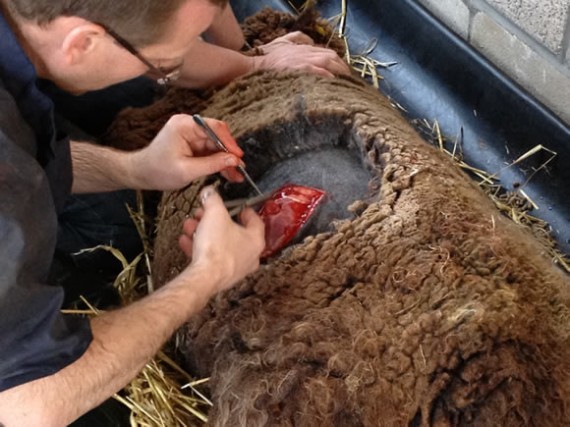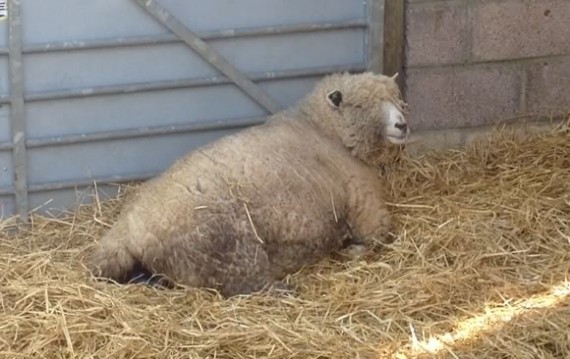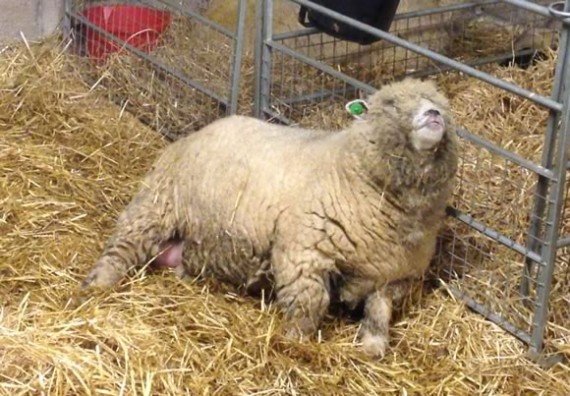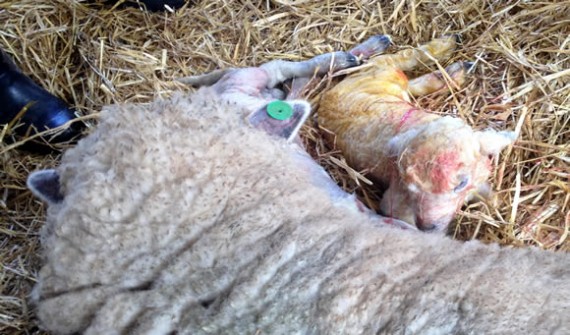Lambing
The best advice I can give here is to get yourself on a lambing course run by a reputable provider. The main purpose of a lambing course, in my opinion, is not to teach you how to deal with every possible malpresentation – it’s to teach you to recognise them and decide quickly whether you are proficient enough to deal with them.
If you aren’t, call the vet or an experienced shepherd that you trust not to have an ego. Too much time spent guddling about can lead to the loss of both lambs and ewe.
 Some malpresentations will need veterinary intervention, like this C-section
Some malpresentations will need veterinary intervention, like this C-section
Most lambs are born without any intervention from the shepherd. The normal presentation is two front feet with the head resting on the front legs – the lamb looks like it’s diving out of the ewe.
Malpresentations include one leg back, both legs back (hung lamb), head back, back feet first and tail first. If there are multiple lambs, it can be a bit of a tangle and if you are lambing twins or triplets, it’s essential that you make sure that the two legs and head that you are “assisting” all belong to the same lamb.
How will I know the ewe is lambing?
If you have raddled your tup, you will know when the ewe was served but although the average gestation period is 147 days, not all ewes have read this.
I have found that, for my Coloured Ryelands, those with singles lamb at 147 days; twins lamb two days later. Mostly.
Some ewes will start to produce milk and the udder will fill up – bagging up – before lambing. But not all ewes do this and first-timers sometimes don’t bag up until birth is imminent.
From labour to birth
It’s difficult to give a timescale as every ewe is different, but on average, from the onset of labour to the birth of the first lamb takes 90 – 120 minutes. From the appearance / bursting of the water bag, there is usually around 30 minutes until the lamb is born. A second lamb may be born almost right away or contractions may stop and it may take another hour for the second (and third) lamb to be born.
Generally, as labour starts, the ewe will look uncomfortable; she may take herself away from the flock (remember, she will be unable to do this as noticeably if the ewes are indoors); she will paw the ground, lie down, stand up, turn round, and lie down again. She will stretch her neck back and may lift her top lip.
 A ewe with her water bag showing
A ewe with her water bag showing
The next step is the breaking of the water bag. This can happen pretty quickly and, if the ewe is startled and moves quickly, you can miss seeing this – once it’s broken, there’s nothing to see.
 Water bag broken, lamb imminent
Water bag broken, lamb imminent
After this, the ewe will start to strain in earnest and soon after, you should see the two feet and a nose – these may appear and disappear a few times but don’t worry about this, all is well and you can let her get on with it. It may take some time, but try not to interfere.
The birth
Once the lamb is born, the ewe may remain lying down for a few minutes; if the lamb is shaking its head and its face is clear of membrane, leave it alone. If the lamb has the birth sac over its head, remove it.
Don’t break the umbilical cord, this will happen naturally when the ewe stands up. In a few minutes, the ewe will get up and start to lick the lamb and begin the bonding process. If the lamb is clearly alive and breathing, leave them to get on with it.
After ten minutes or so, the ewe will have accepted the lamb and you may move them to the mothering pen.
If the ewe is expecting another lamb, then keep an eye on her until the second lamb is safely delivered. If the first lamb is on its feet and starts to wander off, the ewe may birth the second lamb then go off in pursuit of number one lamb, and number two lamb may be lost. So moving to a small pen or making a pen round the ewe is a good idea, but no substitute for good stockmanship.
 New born twin lambs
New born twin lambs
First-time lambers will take forever (it will seem to you), whereas an experienced ewe should be much quicker.
- Previous « Lambing box
- Next Post-natal care »

About Rosemary Champion
Rosemary lives on a 12 acre smallholding in Angus, in the east of Scotland, where she keeps Ryeland Sheep, Shetland cattle and assorted poultry. She was destined to be a smallholder from an early age.
Further Reading
 Sheep Medicine Phillip R. Scott |  Sheep Health, Husbandry and Disease: A Photographic Guide Agnes C. Winter |  The Veterinary Book for Sheep Farmers David Henderson |  The Sheep Keeper's Veterinary Handbook Agnes Winter & Judith Charnley |  Beautiful Sheep: Portraits of Champion Breeds Kathryn Dun |
Smallholding shop
When you click links below and make a purchase, this may result in this site earning a commission from eBay.

Pin Type Ram Crayon - Black each
Pin Type Ram Crayon. Black.… from £1.74 + p&p

First 24 POWDER Colostrum 500g 20 Dose
Premium powder lamb… from £20.60 + p&p

Wax Raidex Marker stick - Green each
Wax Raidex Stick Marker.… from £1.07 + p&p

Raddle Powder - Green 1.5kg
Raddle Powder. Green. 1kg. An… from £3.28 + p&p
















